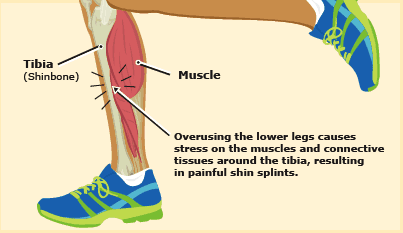
What are shin splints?
After your regular run or just sprint to be somewhere on time, do your shins throb and hurt?
It might be shin splints, or what doctors call it Medial Tibial Stress Syndrome. The reason is stress on your shinbone and the connective tissues that attach muscles to bones. They become sore and inflamed. Shin splints are pains in the lower leg triggered by muscle overuse, and exercise. Shin splints are prevalent when individuals start running, dancing or exercising. Even if you are a regular runner and walker, when you change something about your regimen like moving quicker, increasing distances, or changing shoes, you may experience shin splint pain. It is felt inside your lower leg bone (the tibia). It could be anterior (more towards the front of the leg) or posterior (more to the rear).
 What causes shin splints?
What causes shin splints?
Have you added distance to your riding or biking path, walked on uneven floors, or concrete floors? Did you add more days and intensity to your workout? Shin splints are an inflammation that is thought to be induced by repetitive stress and overuse of bones, tendons, and bone tissue. This is generally seen when your physical activity is unexpectedly increased, either with a new exercise or a change in your present program. Below are some other causes that increase the risk of shin splints:
- Foot arch may be an extra risk factor, with more shin splints seen in individuals with either flat feet or tall, stiff arches. For someone with flat feet, the impact of a step causes the arch of the foot to collapse. A doctor will call this overpronation.
- Shoes that don’t fit well: Working out and some athletic shoes may increase the risk of shin splints. You may experience shin splints when wearing dress shoes or high heels or any other shoes with a comparatively elevated wedge heel.
- Weak knees, hips or key muscle. Runners will feel it more if they increase the distance or speed of their routines.
How to prevent shin pain?
 Time for new shoes
Time for new shoes
Equip yourself to run and walk with appropriate shoes. According to studies, overpronation is a risk factor for shin splint. Look for insoles that absorb the shock. It has been shown that adding a shock-absorbing insole is useful in athletic activities research. Cushioning and support are exhausted every 500 miles in your athletic shoes, often soon before it shows on the soles or uppers.
Rethink your exercising routine
You can also try to alternate your working out days. Give a day of pause to your shins and other body parts between difficult workouts or lengthy days of exercise.
Rest
Stop your exercise at the first indication of shin splint discomfort until the pain passes away. If you need to get home or back in the office, walk at a slower pace and attempt walking on softer floors. Dirt paths are going to be softer, but asphalt is stronger than concrete. Use the recovery period for other activities like swimming or cycling, which will not stress your shins.
How do you treat shin splints?
Expect a thorough physical examination if you see a doctor. They might want to see you running while identifying issues. They may also use X-rays or bone tests to search for fractures. Rest and give your body enough time to heal. To relieve pain and inflammation, ice your shins. Do it every 3 to 4 hours for 2 to 3 days for 20-30 minutes or until the pain is gone. Also, using insoles or orthotics is highly recommended.
Unfortunately, many beginner exercisers and runners will develop shin splints and for a lot of them, this will be enough to halt their trip to wellness. Fortunately, there are ways to treat the symptoms. At Custom Chiropractor we offer Active Release Therapy and Deep Tissue Massage to relieve the pain and treat the condition. A qualified practitioner will show you drills and methods that your leg muscles need to reinforce and balance towards a faster recovery for your shins. If you are in the Santa Clara – San Jose Area and you have swelling that gets worse, or if the pain doesn’t get easier with self-care schedule an appointment and come see one of our healthcare providers.






